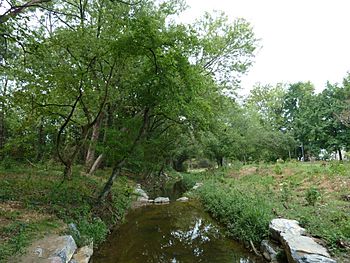Watts Branch (Anacostia River tributary) facts for kids
Quick facts for kids Watts Branch |
|
|---|---|

A restored portion of Watts Branch in 2011
|
|
| States | Maryland |
| County | Prince George's County, Maryland |
| City | Washington, D.C. |
| Physical characteristics | |
| Main source | 38°52′14″N 76°54′16″W / 38.8706432°N 76.9045399°W |
| River mouth | Anacostia River 38°54′21″N 76°57′26″W / 38.905706°N 76.957115°W |
| Length | 4.9 miles (7.9 km) |
| Basin features | |
| River system | Potomac River |
| Basin size | 11,500 acres (47 km2) |
Watts Branch is a smaller river, also called a tributary, that flows into the Anacostia River. It runs through parts of Prince George's County in Maryland and also through Washington, D.C..
Contents
Where Watts Branch Flows
The Watts Branch river starts in the Capitol Heights area of Prince George's County. The very beginning of a river is called its headwaters.
From there, Watts Branch flows generally towards the northwest for about 4.9 miles (7.9 kilometers). It eventually joins the Anacostia River. The Anacostia River then flows into the Potomac River, which finally empties into the Chesapeake Bay.
The area of land that drains water into Watts Branch is called its watershed. This watershed covers about 6,000 acres (24 square kilometers) in Prince George's County. Another 5,500 acres (22 square kilometers) of its watershed are in Washington, D.C.
Water Quality and Cleanup Efforts
Watts Branch flows through a very developed area, meaning there are many buildings, roads, and people. Because of this, government groups have said that the water quality in Watts Branch is not very good.
Why the Water Quality is Poor
The stream has been affected by different kinds of pollution. One major problem is urban runoff. This is rainwater that flows over streets and parking lots, picking up trash, oil, and other pollutants. It then carries these into the stream.
Other issues include trash that has been dumped directly into the stream. Sometimes, pipes that carry waste from homes, called sanitary sewer pipes, can leak. These leaks can also add pollution to the water.
A lot of Watts Branch has been changed by humans. Parts of the stream flow through concrete channels or underground pipes called culverts. This changes how the stream naturally flows and affects the animals that live there.
Working to Make it Better
Many groups are working hard to clean up and improve Watts Branch. This is called stream restoration. The D.C. government, the United States Environmental Protection Agency (EPA), and other federal groups are involved.
They work together with local community organizations. These groups include the Anacostia Riverkeeper, the Anacostia Watershed Society, Groundwork Anacostia, and the Watts Branch Community Alliance. Their goal is to make Watts Branch a healthier and cleaner place for everyone.

